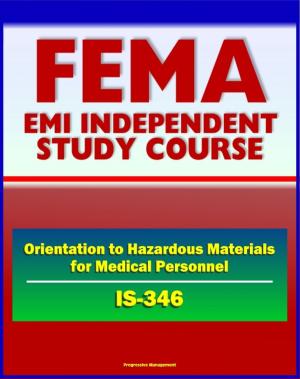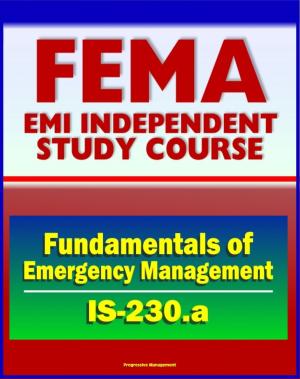20th Century Nuclear Power Plant Accidents: 1986 Chernobyl Accident and Radioactive Release (Chornobyl Atomic Power Station) USSR, Health Consequences, Cesium, Iodine, Thyroid Cancer, Lessons
Nonfiction, Science & Nature, Science, Physics, General Physics, Social & Cultural Studies, Political Science| Author: | Progressive Management | ISBN: | 9781458118677 |
| Publisher: | Progressive Management | Publication: | March 13, 2011 |
| Imprint: | Smashwords Edition | Language: | English |
| Author: | Progressive Management |
| ISBN: | 9781458118677 |
| Publisher: | Progressive Management |
| Publication: | March 13, 2011 |
| Imprint: | Smashwords Edition |
| Language: | English |
The 1986 radiation accident at the Chernobyl Atomic Power Station in the Ukraine is fully covered in this authoritative collection of official documents with details about the accident and its aftermath, including the immediate and long-term health consequences, the release of radioactive cesium and iodine, thyroid cancer cases, the containment of the destroyed Unit 4 reactor, American reaction and response, and much more.
On April 26, 1986, an accident occurred at Unit 4 of the nuclear power station at Chernobyl, Ukraine, in the former USSR. The accident, caused by a sudden surge of power, destroyed the reactor and released massive amounts of radioactive material into the environment. To stop the fire and prevent a criticality accident as well as any further substantial release of fission products, boron and sand were poured on the reactor from the air. In addition, the damaged unit was entombed in a temporary concrete "sarcophagus," to limit further release of radioactive material. Control measures to reduce radioactive contamination at and near the plant site included cutting down and burying a pine forest of approximately 1 square mile. After the accident, access to the area in a 30-kilometer (18-mile) radius around the plant was closed, except for persons requiring official access to the plant and to the immediate area for evaluating and dealing with the consequences of the accident and operation of the undamaged units. The population evacuated from the most heavily contaminated areas numbered approximately 116,000 in 1986 and another 230,000 people in subsequent years. Pripyat, the town near Chernobyl where most of the workers at the plant lived before the 1986 accident, was evacuated several days after the accident, because of radiological contamination. It was included in the 30-km Exclusion Zone around the plant and is closed to all but those with authorized access. The Chernobyl accident caused many severe radiation effects almost immediately. Among the approximately 600 workers present on the site at the time of the accident, 2 died within hours of the reactor explosion and 134 received high radiation doses and suffered from acute radiation sickness. Of these, twenty eight workers died in the first four months after the accident. Another 200,000 recovery workers involved in the initial cleanup work of 1986-1987 received doses of between 0.01 and 0.50 Gy. The number of workers involved in cleanup activities at Chernobyl rose to 600,000, although only a small fraction of these workers were exposed to dangerous levels of radiation. Both groups of cleanup and recovery workers may become ill because of their radiation exposure, so their health is being monitored. The Chernobyl accident also resulted in widespread contamination in areas of Belarus, the Russian Federation, and Ukraine inhabited by millions of residents. Radiation exposure to residents evacuated from areas heavily contaminated by radioactive material from the Chernobyl accident also has been a concern. However, the majority of the five million residents living in contaminated areas received very small radiation doses which are comparable to natural background levels (1 mSv per year). The health of these residents also has been monitored since 1986, and to date there is no strong evidence for radiation-induced increases of leukemia or solid cancer (other than thyroid cancer). It is estimated that approximately 4,000 radiation-related cancer deaths may eventually be attributed to the Chernobyl accident over the lifetime of the 200,000 emergency workers, 116,000 evacuees, and 270,000 residents living in the most contaminated areas. This estimate is far lower than initial speculations that radiation exposure would claim tens of thousands of lives, but it is not greatly different from estimates made in 1986 by Soviet scientists.
This is a privately authored news service and educational publication of Progressive Management.
The 1986 radiation accident at the Chernobyl Atomic Power Station in the Ukraine is fully covered in this authoritative collection of official documents with details about the accident and its aftermath, including the immediate and long-term health consequences, the release of radioactive cesium and iodine, thyroid cancer cases, the containment of the destroyed Unit 4 reactor, American reaction and response, and much more.
On April 26, 1986, an accident occurred at Unit 4 of the nuclear power station at Chernobyl, Ukraine, in the former USSR. The accident, caused by a sudden surge of power, destroyed the reactor and released massive amounts of radioactive material into the environment. To stop the fire and prevent a criticality accident as well as any further substantial release of fission products, boron and sand were poured on the reactor from the air. In addition, the damaged unit was entombed in a temporary concrete "sarcophagus," to limit further release of radioactive material. Control measures to reduce radioactive contamination at and near the plant site included cutting down and burying a pine forest of approximately 1 square mile. After the accident, access to the area in a 30-kilometer (18-mile) radius around the plant was closed, except for persons requiring official access to the plant and to the immediate area for evaluating and dealing with the consequences of the accident and operation of the undamaged units. The population evacuated from the most heavily contaminated areas numbered approximately 116,000 in 1986 and another 230,000 people in subsequent years. Pripyat, the town near Chernobyl where most of the workers at the plant lived before the 1986 accident, was evacuated several days after the accident, because of radiological contamination. It was included in the 30-km Exclusion Zone around the plant and is closed to all but those with authorized access. The Chernobyl accident caused many severe radiation effects almost immediately. Among the approximately 600 workers present on the site at the time of the accident, 2 died within hours of the reactor explosion and 134 received high radiation doses and suffered from acute radiation sickness. Of these, twenty eight workers died in the first four months after the accident. Another 200,000 recovery workers involved in the initial cleanup work of 1986-1987 received doses of between 0.01 and 0.50 Gy. The number of workers involved in cleanup activities at Chernobyl rose to 600,000, although only a small fraction of these workers were exposed to dangerous levels of radiation. Both groups of cleanup and recovery workers may become ill because of their radiation exposure, so their health is being monitored. The Chernobyl accident also resulted in widespread contamination in areas of Belarus, the Russian Federation, and Ukraine inhabited by millions of residents. Radiation exposure to residents evacuated from areas heavily contaminated by radioactive material from the Chernobyl accident also has been a concern. However, the majority of the five million residents living in contaminated areas received very small radiation doses which are comparable to natural background levels (1 mSv per year). The health of these residents also has been monitored since 1986, and to date there is no strong evidence for radiation-induced increases of leukemia or solid cancer (other than thyroid cancer). It is estimated that approximately 4,000 radiation-related cancer deaths may eventually be attributed to the Chernobyl accident over the lifetime of the 200,000 emergency workers, 116,000 evacuees, and 270,000 residents living in the most contaminated areas. This estimate is far lower than initial speculations that radiation exposure would claim tens of thousands of lives, but it is not greatly different from estimates made in 1986 by Soviet scientists.
This is a privately authored news service and educational publication of Progressive Management.















